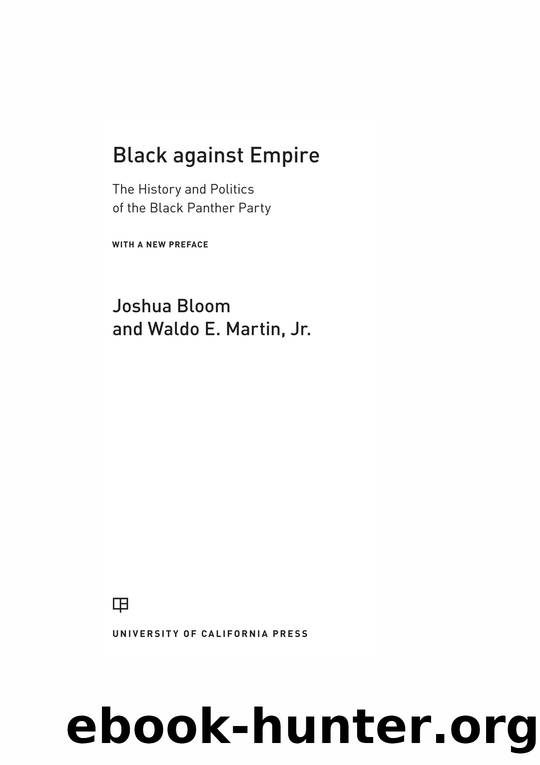Black against Empire by Joshua Bloom

Author:Joshua Bloom
Language: eng
Format: epub
ISBN: 9780520271852
Publisher: University of California Press
13
Vanguard of the New Left
Yolanda Lopez and Donna Amador, activists from the San Francisco State strike, were at the Free Huey rally on May 1, 1969, along with Ralph Ruiz when, as Amador recalls, “I was standing in the back of the crowd near a police motorcycle when I heard from a crackling radio that a police officer had just been shot in San Francisco’s Mission District (my home). An all-points bulletin went out for a number of Latin men, and, coincidentally, one of the suspects [Ralph Ruiz] was standing right beside me! My priorities changed instantly. Education was important for the brothers and sisters, but the fight for freedom from the oppression and injustice of the real world suddenly took me away from SFSU [San Francisco State University].”1
Earlier that day, San Francisco police officers Joe Brodnik and Paul McGoran, both undercover, approached a group of young Latinos moving a television from their car into an apartment. Officer McGoran, who had been drinking that morning, called the youths “wetbacks” and a number of insults were exchanged. A fight broke out, and by the end, Brodnik had been killed with McGoran’s gun. Despite evidence that four of the seven young Latino activists charged with the shooting were elsewhere at the time and with no clear argument about who had actually shot Brodnik, the prosecution charged all seven with first-degree murder and called for their execution. In response, San Francisco police raided more than 150 homes in the Mission District, claiming they were searching for the seven young men they said had shot Brodnik. The Black Panther asked rhetorically, “Was that pig Brodnik shot by the many thousands of Brown people who live in San Francisco’s Mission District?”2
The seven Latinos charged—Tony and Mario Martinez, Nelson Rodri quez, Jose Rios, George “Gio” Lopez, Gary Lescallet, and Danilo “Bebe” Melendez—were active in student efforts to force the administration to institute Third World curricula and enrollment at the College of San Mateo. They came to be known as Los Siete de la Raza (roughly, the seven Latinos). Many young Latinas and Latinos in San Francisco’s Mission District had initially become politically active through the Mission Rebels, a federally funded program for low-income youth. Both the San Francisco State strike and conflicts with police had radicalized many young activists in the Mission District. When Los Siete were accused of murder, the charge gave young Mission District activists a focal point for their political energies.
Having gotten to know the Black Panthers during the SF State strike, Los Siete supporters Roger Alvarado and Donna Amador approached Bobby Seale for help, and the Panthers immediately came to their assistance. The Panthers offered Los Siete supporters publication assistance, shared the stage at rallies, introduced them to their lawyer Charles Garry, committed $25,000 to their legal defense, and mentioned Los Siete when they were interviewed on the evening news.
On June 28, 1969, the Black Panther headline was “Free the Latino Seven,” and the newspaper featured a full-page cover graphic of Mexican revolutionary Emiliano Zapata and six photos of members of Los Siete de la Raza.
Download
This site does not store any files on its server. We only index and link to content provided by other sites. Please contact the content providers to delete copyright contents if any and email us, we'll remove relevant links or contents immediately.
The Secret History by Donna Tartt(18852)
The Social Justice Warrior Handbook by Lisa De Pasquale(12143)
Thirteen Reasons Why by Jay Asher(8800)
This Is How You Lose Her by Junot Diaz(6796)
Weapons of Math Destruction by Cathy O'Neil(6148)
Zero to One by Peter Thiel(5690)
Beartown by Fredrik Backman(5600)
The Myth of the Strong Leader by Archie Brown(5427)
The Fire Next Time by James Baldwin(5250)
How Democracies Die by Steven Levitsky & Daniel Ziblatt(5129)
Promise Me, Dad by Joe Biden(5088)
Stone's Rules by Roger Stone(5027)
A Higher Loyalty: Truth, Lies, and Leadership by James Comey(4846)
100 Deadly Skills by Clint Emerson(4843)
Rise and Kill First by Ronen Bergman(4705)
Secrecy World by Jake Bernstein(4651)
The David Icke Guide to the Global Conspiracy (and how to end it) by David Icke(4628)
The Farm by Tom Rob Smith(4439)
The Doomsday Machine by Daniel Ellsberg(4419)
